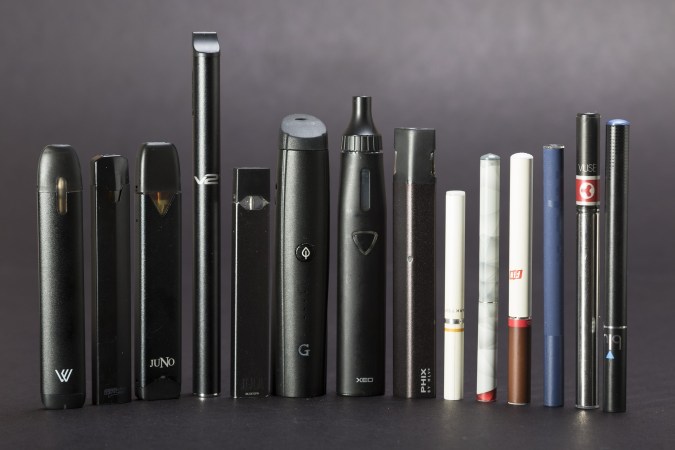

Here’s some good news: Cigarette smoking hit record lows in the US, according to a new Centers for Disease Control and Prevention survey. An estimated 11.1 percent of American adults were regular cigarette users in 2022—a drop from the 14.4 percent reported in 2019.
The decline in smoking did not happen overnight. Since the 1960s, public health experts have been fighting against the glamorization of cigarettes to raise awareness of the danger they pose on human health. Cigarettes continue to be the leading cause of preventable death in the US with one in five deaths are related to a person’s smoking history. And while the recent news is a victory towards a healthier nation, e-cigarettes and other vaping products could make this a short-lived triumph.
What’s causing smoking rates to decrease?
Public health awareness
The decline first began in 1964 when the Surgeon General released a report linking cigarette smoking to a number of health problems, including a 70-percent increased risk of premature death and a nine- to tenfold risk of lung cancers compared to non-smokers. Since then, there has been a push for educational campaigns to teach people about the dangers of smoking to your health.
Social stigma
For decades, the media glamorized smokers as cool, rebellious, or fashionable. (Holly’s cigarette holder from Breakfast at Tiffany’s has even become an iconic accessory.) Even in real life, there were social repercussions when people went out for smoking breaks or smoked in a restaurant.
Again, the public perception of smoking started to shift after the Surgeon General’s report. The Food and Drug Administration (FDA) made companies print medical warnings of the dangers of smoking on every cigarette pack. In 1971, TV and radio channels banned cigarette ads and showed more anti-cigarette ads that would scare people with graphic images of the effects of tobacco, like people with permanent holes in their neck after contracting smoke-related throat cancer. Medical research on tobacco continued to link cigarette smoking to several preventable diseases and health problems. Lawmakers passed stricter regulations on cigarettes, including a ban on smoking at work and in most public areas.
Nowadays, most indoor spaces like hotels and theaters don’t allow smoking; instead, people tend to slip out to take a quick cigarette break and spray their clothes down to hide the smell of cigarettes. Vincent Mase, a thoracic surgeon at Yale University School of Medicine in Connecticut, says smoking cigarettes has been more socially unacceptable among younger generations. He says tobacco smoke has become more taboo, too, because of how it affects a person’s hygiene with increased sweating, yellow teeth, and of course, the smell.
Higher taxes
Smoking is expensive. While varying by state, the average cost for a pack in the US is $8. New York, for example, is the most expensive state to buy cigarettes at $11.96 while Missouri is the cheapest at $6.11. The varying prices come from a combination of state taxes and a federal tax. Increasing the price of cigarettes has helped deter young adults between 18 to 24 years old from pursuing the costly habit. It has also been an effective tactic in getting current smokers to quit, especially Black and Hispanic individuals. “if you look at an area like New York where the cigarette tax is very high, the smoking rate is very low. Compare that to a state like Kentucky, where the tax rate on cigarettes is low and smoking is relatively high,” explains Norman Edelman, a pulmonologist at Stony Brook University in New York. “Although it is falling everywhere, as people realize the deleterious effects of smoking.”
How to drive smoking rates down further
While it’s unlikely we’ll ever have a cigarette-free society, there are ways of pushing the rates as close to zero as possible.
Banning menthol
Menthol is a chemical found in peppermint that changes how the brain processes taste and pain. It leaves a cool sensation in the throat and airways that acts as a local anesthetic and can mask the irritation cigarette smoke causes to the lungs. Because menthol makes the smoke less harsh, it encourages users to inhale more deeply and might increase exposure to other toxins such as carbon monoxide. While almost all cigarettes sold in the US have menthol, those with higher quantities are marketed as menthol-flavored.
Another concern with menthol is that it can increase cigarette addiction. Several studies found menthol stops the breakdown of nicotine, letting the stimulant exert its effects for longer. Enhancing the addictive effects of nicotine makes it harder for people who use menthol-flavored cigarettes to quit. In 2022, the FDA proposed a nation-wide ban on menthol-flavored cigarettes to curb its appeal—the decision is expected to be handed down later this year.
[Related: The environmental argument for banning menthol cigarettes]
Edelman says there’s no question that menthol should be banned—but he’s not sure how much it would help curb smoking rates across the US. Canada’s experience in banning menthol-flavored cigarettes from 2015 to 2018 may provide some idea on what to expect. A 2022 study in The BMJ found that after the ban, chronic menthol smokers were more likely to stop smoking daily than non-menthol smokers. The authors estimate a similar prohibition in the US would help 789,724 daily smokers break the habit.
Increase on federal taxes
The current federal tax on cigarettes is $1.01 per pack. This reflects the latest increase in 2009 where federal taxes were raised to 62 cents a pack. The American Lung Association has advocated matching federal taxes to the rate of a state’s cigarettes tax to not only make cigarettes less affordable, but also increase funding for tobacco prevention efforts.
Less smoking, but more vaping
The same CDC survey reporting a decline in smokers has also found a rise in e-cigarette users. In 2022, 6 percent of people in the US use an electronic cigarette or other electronic vaping product—a 1.6 percent jump from 2019.
The first e-cigarette was invented in 2003 as a less harmful and smelly alternative to traditional cigarettes. These battery-operated devices have since grown in popularity, especially among older kids. Not only are they more affordable than cigarettes—the average cost for a disposable e-cigarette is $8.01 and e-liquid cartridges are $6.83—but they come in appetizing flavors like mint, strawberry, cotton candy, bubblegum. Like menthol, the different flavors mask the harsh taste of smoke, which allows users to take more puffs.
Mase says younger crowds prefer the product because of several common misconceptions surrounding e-cigarettes. A 2017 study surveyed adolescents on their attitudes towards vaping. About 19 percent of high schoolers believed e-cigarette smoke is water, 23 percent though e-cigarettes was not a tobacco product, and 43 percent thought they were safer than cigarettes. Mase warns that a number of short-term studies have linked vaping to respiratory symptoms and lung damage in adolescents. Last month, several state attorney generals reached a $462 million settlement with top e-cigarette brand JUUL for advertising to teens and making false claims that its products were harmless. The FDA also recently ordered the removal of JUUL products from the US market, citing health concerns and insufficient data on the toxicity of the vapes.
[Related: A $25 whistle-like tool could be a game changer for COPD patients]
Unlike regular cigarettes, there are no blanket regulations against vaping products in the US, so users can’t be completely sure of what they’re breathing in. “Every so often we get a rash of people getting sick because they’ve been inhaling something they shouldn’t inhale,” says Edelman. In 2018, there was an outbreak of vaping-related lung injuries and deaths: The culprit was vitamin E acetate being added to e-cigarettes and other vaping products that contained THC. While vitamin E is safe to consume and apply topically, it can affect a person’s lung function when smoked.
The lungs are one of the few organs in the body that makes contact with the outside environment, says Edelman. Just as shades protect the eyes and sunscreen protects the skin, not smoking is one way to keep lungs healthy and functioning for years to come.
Correction (May 9, 2023): The story previously stated that vitamin E acetate had been added to some cigarettes, leading to lung injuries and deaths in users. The vitamin E acetate was specifically added to THC-containing e-cigarettes and other vaping products.







